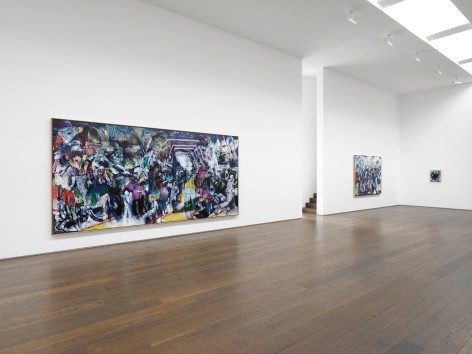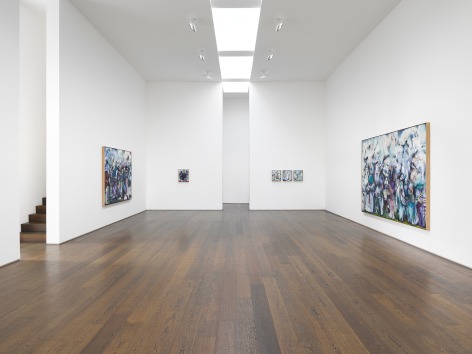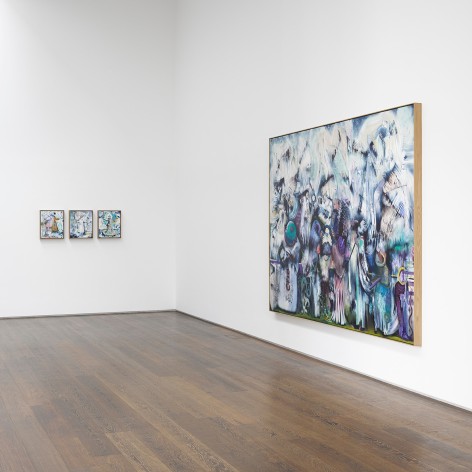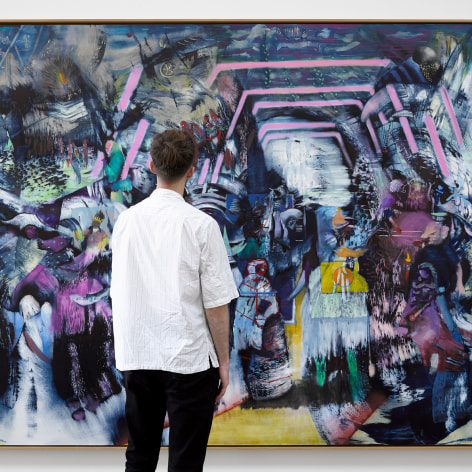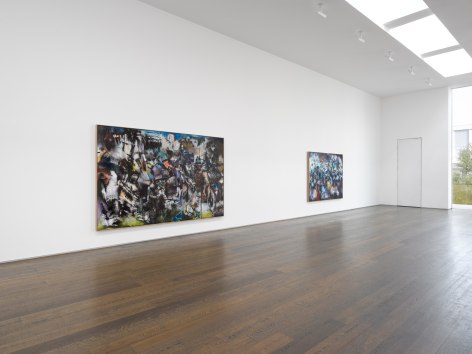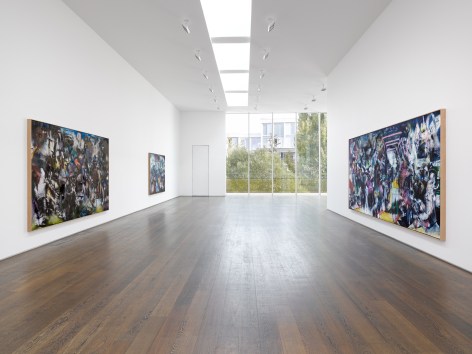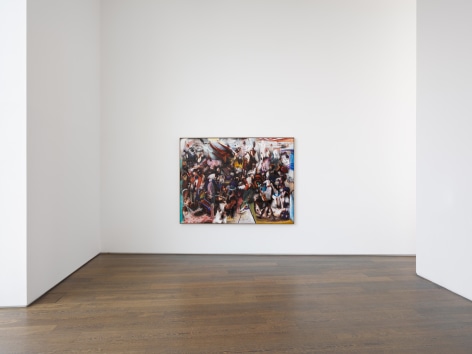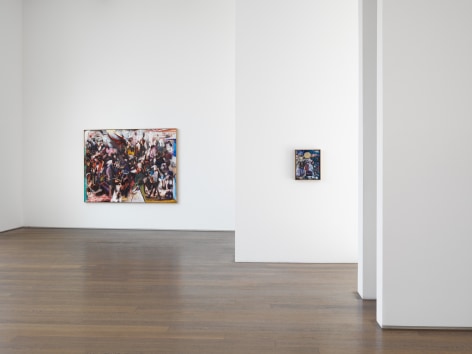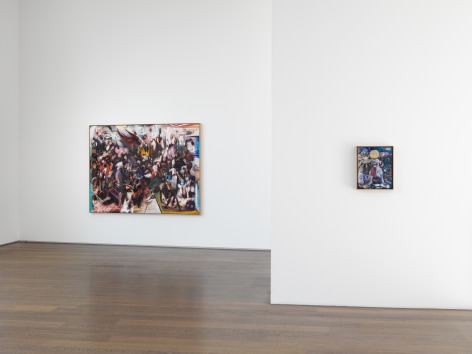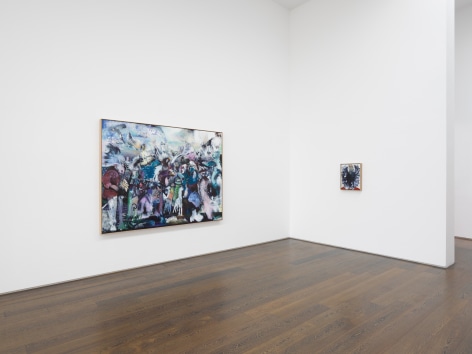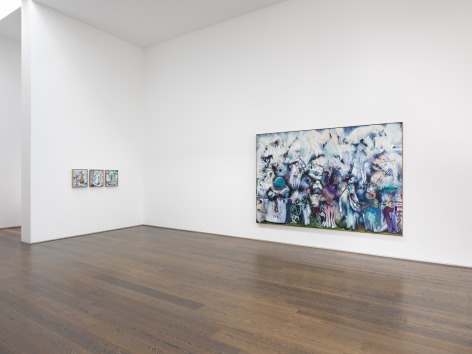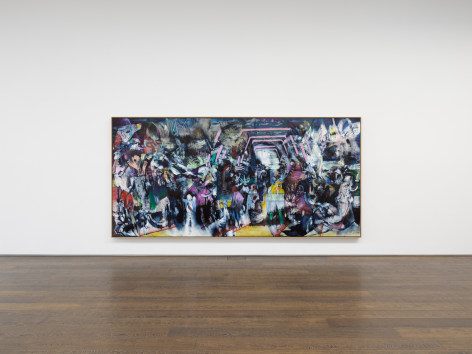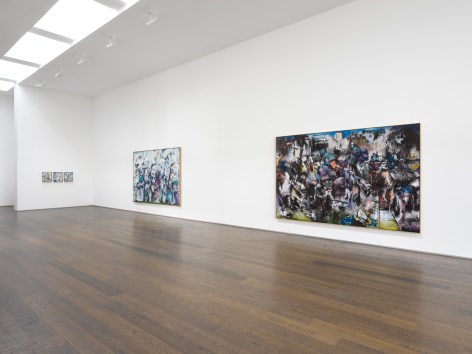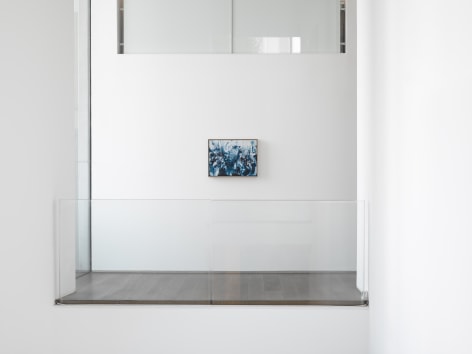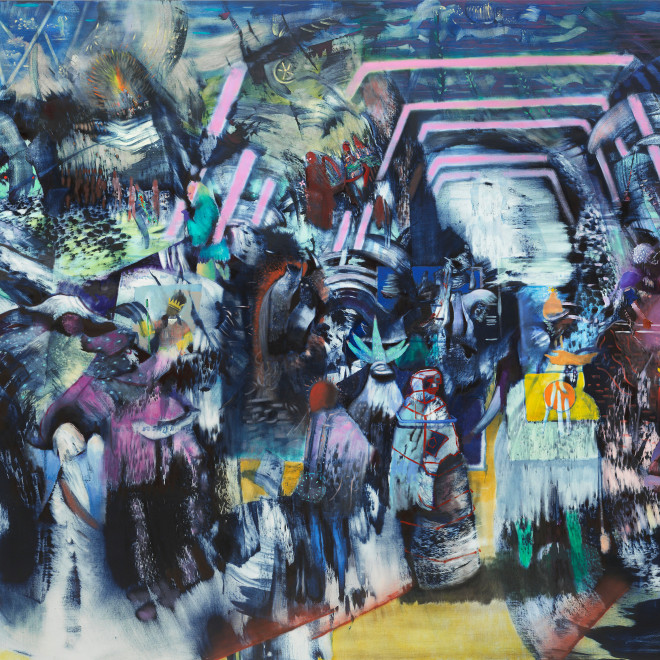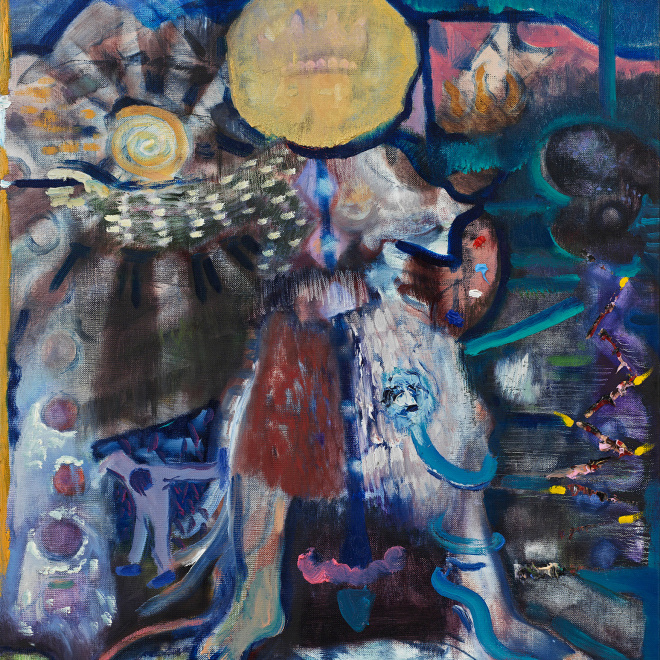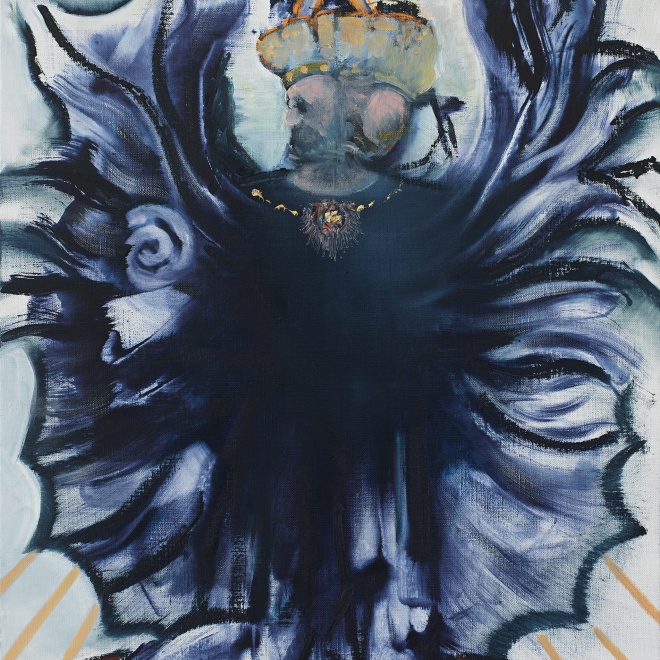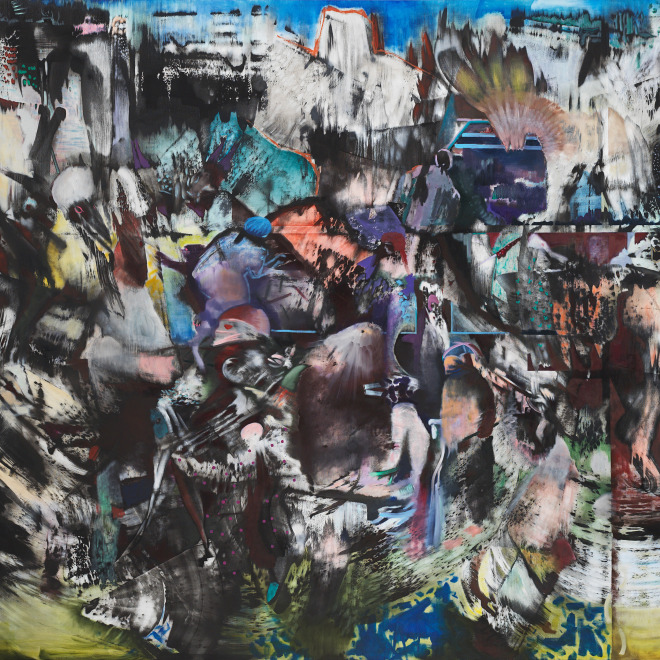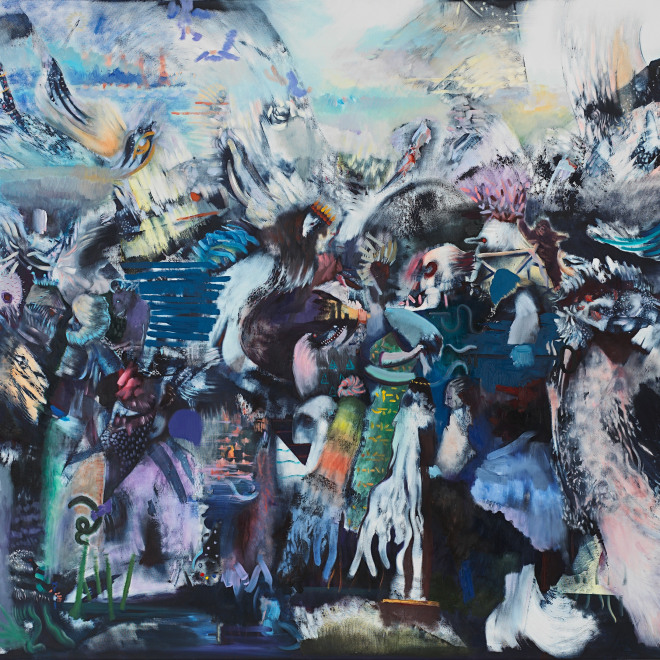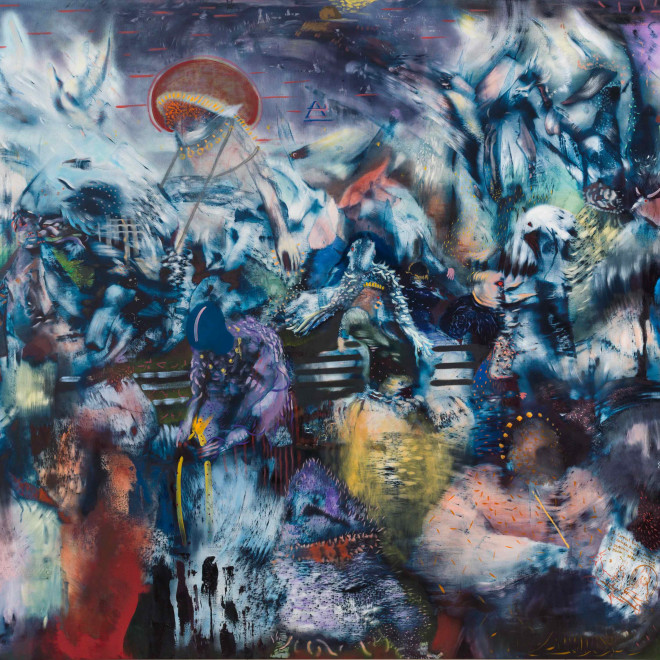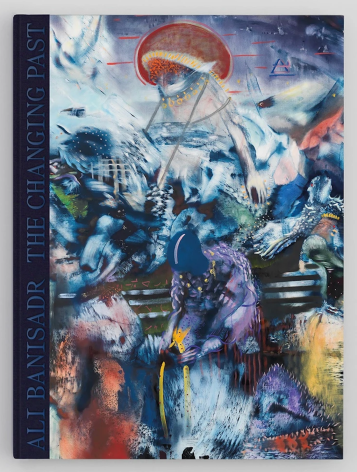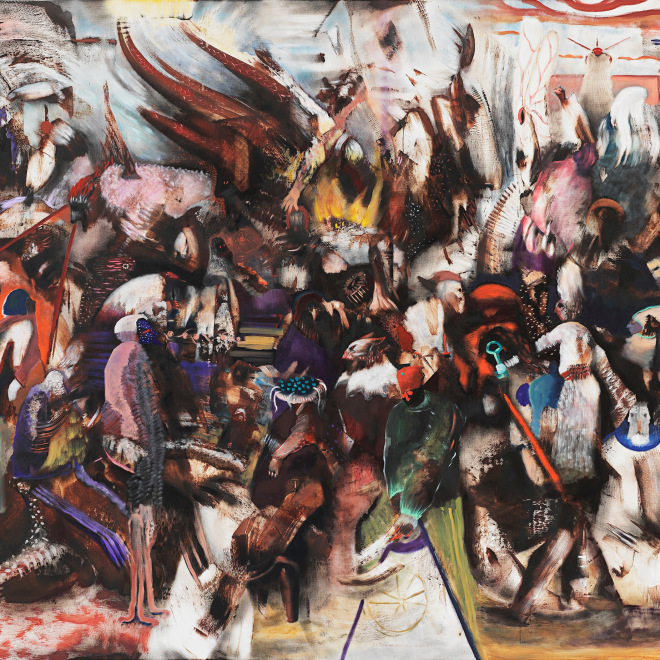
Victoria Miro is delighted to announce an exhibition of paintings by Ali Banisadr in London this autumn. Opening in October, the first solo presentation of works by the New York-based artist since he joined the gallery in 2021 features a substantial body of paintings completed over the past two years. The exhibition will be accompanied by a catalogue featuring new writing on the artist.
‘Those who contemplate the paintings of Ali Banisadr for any length of time can receive the impression that this pictorial world is all about a quest of some sort, perhaps the quest for a universe, for a unified whole.’ — Doris von Drathen
A painter of epic vistas and dazzling intricacies, Ali Banisadr creates complex worlds whose syncopated rhythms corral a multitude of references from history and art history, as well as allusions to our own turbulent times. In any single, expansive canvas one might sense the crystalline detail of the Persian miniature tradition, the muscular brushwork of Abstract Expressionism, the narrative dexterity of the early Dutch masters, the bravura technique of the Venetian Renaissance, or the libidinous glyphs of Surrealism, among others.
Banisadr’s works invite the viewer to move through time, encountering different art histories and different cultures while contemplating contemporary issues through the lens of the past. Works on view will include Queen of the Night, 2022, a large- scale painting inspired by The Burney Relief (also referred to as the Queen of the Night relief), which is on display in the British Museum, London. A Mesopotamian terracotta relief made in the Old-Babylonian period (19th–18th century BCE), it depicts a winged deity, with bird feet and prominent talons, wearing a headdress of horns, elaborate jewellery, holding a rod and ring in each hand. In Mesopotamian art, the rod and ring symbol, like the horned helmet or crown, are indicators of the depicted being’s divine status. This symbol also represents ‘respect’, ‘justice’ and the ‘balance of power’.
This figure stands in the centre of Banisadr’s painting, addressing the viewer. To the left stands a high priestess equally adorned with jewellery, with the symbol for ‘woman’ and ‘life’ on the front of her gown. Also in attendance are other bird-like creatures of divine status. In Mesopotamia, birds were often symbolic of the future. Born in Tehran in 1976, Banisadr has commented on childhood memories of the Islamic revolution and the Iran-Iraq war as being ‘a mix of images, half abstract and half recognisable forms.’ Symbolism relating to present-day events in the country, and how these are received and consumed around the world, lend Queen of the Night an urgency that speaks candidly to the contemporary moment.
Also on view, The Changing Past, 2021, evokes the ways in which, throughout history, monuments, buildings and often entire cultures are toppled or erased in order to accommodate new beliefs and ideas, which in turn are succeeded by further layers of thinking or sets of ideals. Reflective of Banisadr’s ongoing interest in iconoclasm, the motifs in the painting are trans-historical: a disc, for instance, refers to a symbol from Ancient Egyptian times that migrates through time, its meaning and significance changed. Shifting thoughts and philosophies similarly echo through the work. G.I. Gurdjieff, the Russian born, Greco- Armenian philosopher, mystic and spiritual teacher whose work helped to bring ancient teachings and mysticism to the West, is cited as an influence. An enduring source of inspiration is the ancient Mesopotamian poem The Epic of Gilgamesh, which provides the artist with a rich source of visual imagery.
In Banisadr’s art such references reveal themselves not as static, sedimentary layers but as successive waves or currents. His abstract and semi-abstract forms flow together, intermingle or collide, submerging and resurfacing through the process of painting to become recast and transformed. With their legions of strafing lines, arcs, blurs and smears of colour, Banisadr’s paintings equally evoke the fractured and shimmering surfaces of our digital world.
Ali Banisadr’s exhibition is accompanied by a publication featuring an interview with John Yau and new writing on the artist by Doris Von Drathen and Charlotte Mullins.
‘In These fragments I have shored against my ruins, which is the largest painting in the show, there are elements of disruption by a foreign entity, which in my mind is a digital entity, such as AI or social media. I have always been interested in the disruption of technology and how it can change us as human beings to become another type of being.’ — Ali Banisadr
‘Banisadr paints our world, the world of time’s arrow, but in doing so he explores the crossovers with time’s cycle, with deep time, revealing the cyclical nature of humanity with its endless wars, its perpetual growth and decay.’ — Charlotte Mullins
‘In Lapis, we see an anthropomorphic polar land under a frigid blue sun, the figures reduced to glimpses of hands, eyes, beaks, fish scales.’ — Charlotte Mullins
‘For the first time in these pictures, the whirling images seem to be articulated by right angles and underlying cubes as if the painting were underpinned by a semi-concealed geometric structure… But these right angles are unable to contain the explosion of pictorial detail.’ — Doris von Drathen
‘Rebis can be considered as the final stage in the alchemical magnum opus, a universal amalgam of female and male bedecked with five six-pointed stars, one of them at the centre of the figure’s Janus head.’ — Doris von Drathen
‘The Rebis figure goes back to ancient Mesopotamia. This was the figure of worship in ancient days; it is a perfect being, a balanced being. It is also about identity. The diasporic people tend to look for fragments and multiplicity to understand the self, to understand home.’ — Ali Banisadr
‘The procession halts but the spirits, our ancestors, continue to look on. Alchemical symbols float over robes and heads while red eyes burn, carnal and devilish, other-worldly. We are in a Borges tale, an Eliot poem, a Rumi fable, an Upanishad.’ — Charlotte Mullins
‘The presence of the artist/painter is always important in my work; for example the kneeling figure in this painting who is juggling a snake, candles and a palette, which ultimately tells the viewer about the amount of work the painter has to do by juggling so many things, out of desperation for the painting to come together. The painter is willing to do anything for it to materialise’ — Ali Banisadr
‘The multiplicity of perspectives and pictorial fragments in every painting explodes not only space but also time and cultural epochs: the mystical rubs shoulders with the mythological, the historical-political with the alchemical or archaic.’ — Doris von Drathen
‘I think I am trying to enter an abyss… I want to go further and further and suddenly I’m in the dark. That’s when it becomes scary, but also exciting. Where am I? What is this? You know, where’s this road going?’ — Ali Banisadr
About the artist
Born in 1976 in Tehran, Iran, Ali Banisadr lives and works in Brooklyn, NY. Recent solo institutional exhibitions include Ali Banisadr: Beautiful Lies at Museo Bardini and Palazzo Vecchio, both in Florence, Italy (2021); Ali Banisadr/Matrix 185, Wadsworth Atheneum Museum of Art, Hartford, CT, USA (2020), and Ultramarinus – Beyond the Sea, Benaki Museum, Athens, Greece (2020). His work has been included in recent institutional group exhibitions including Daphne without Apollo: Metamorphoses from Richter to Lassnig, The Opelvillen Foundation, Rüsselsheim, Germany, (2022); Epic Iran, V&A, London, UK (2021); A Boundless Drop to a Boundless Ocean, Orlando Museum of Art, Florida, USA (2021); Rebel, Jester, Mystic, Poet: Contemporary Persians, Asia Society, New York, NY, USA (2021).
Work by the artist is included in major institutional collections including: Albright-Knox Art Gallery, Buffalo, NY, USA; Akademie der Bildenden Künste, Vienna, Austria; British Museum, London, UK; Centre Pompidou, Paris, France; Het Noordbrabants Museum, Den Bosch, Netherlands; Hirshhorn Museum and Sculpture Garden, Washington, DC, USA; K11 Art Foundation, Hong Kong; Los Angeles County Museum of Art, Los Angeles, CA, USA; The Metropolitan Museum of Art, New York, USA; Museum of Contemporary Art, Los Angeles, CA, USA; The Museum of Fine Arts, Houston, USA; Museum der Moderne, Salzburg, Austria; Miniature Museum, The Hague, Netherlands; Philadelphia Museum of Art, Philadelphia, PA, USA; Francois Pinault Foundation, Palazzo Grassi, Venice, Italy; Wadsworth Atheneum Museum of Art, Hartford, CT, USA; among others. The first major monograph on the artist was published by Rizzoli in 2021.

